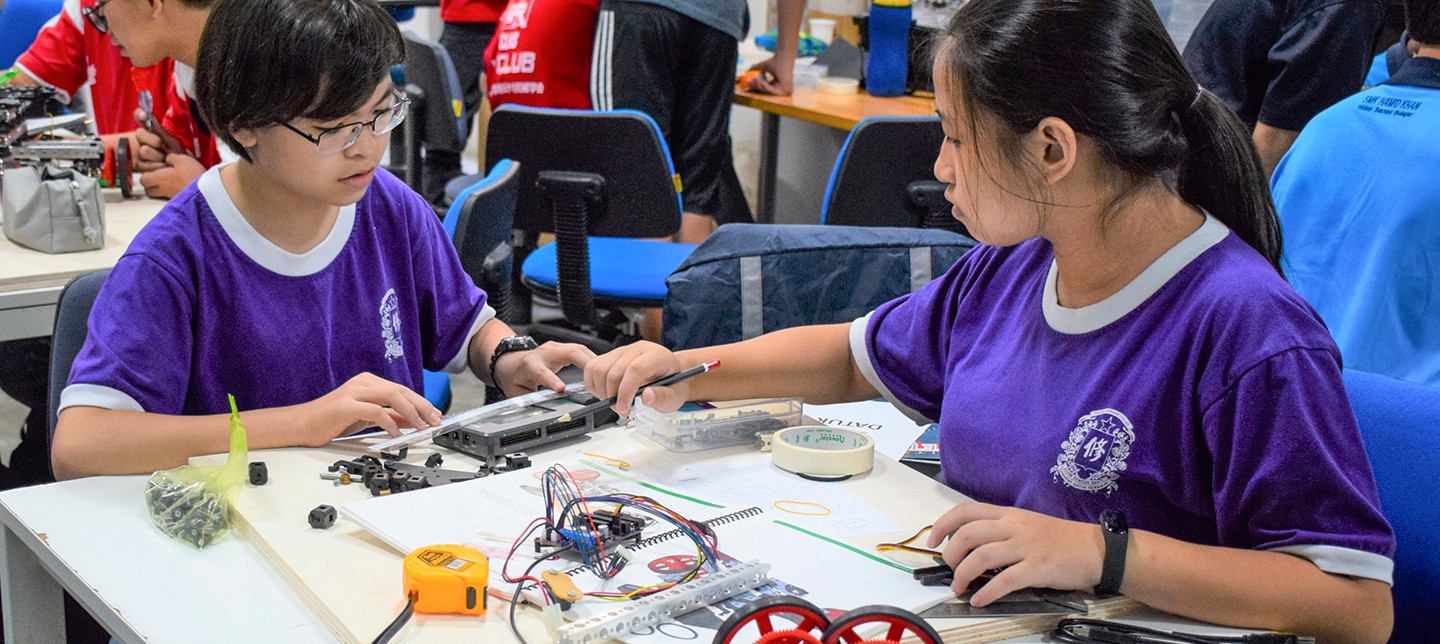
Electro Rent and NI Are Expanding Possibilities
NI and Electro Rent’s global rental collaboration offers customers new opportunities to increase flexibility, lower costs, and minimize environmental impacts of test equipment life cycles.

Over her 30-year engineering career, Azian Wahab has been part of many exciting innovations. At Motorola, she led a team to design and develop two-way digital communication products used globally by public safety, commercial, and industrial sectors. And at NI, she helped open the company’s Penang, Malaysia, site and managed R&D operations. But there’s one area of the industry where she hasn’t seen as much progress.
“The number of women in engineering hasn’t changed much at all since I started,” said Azian, who is now NI’s Asia-Pacific corporate impact lead. Based in Penang, she helms the company’s giving programs throughout the region.
According to the Board of Engineers Malaysia, in 2019, women represented about 7 percent of professional engineers with practicing certificates, which is the highest professional level engineers tend to achieve in Malaysia.
As Azian developed NI’s partnership with the Penang Science Cluster (PSC), a local nonprofit promoting science and technology, over the last decade, she noticed the same trend among the younger generation. There were very few female students attending PSC engineering programs such as its NI-sponsored LEGO® Robotics workshops.
“One day I asked my colleagues at PSC: Where are all the girls?” said Azian.
GET was developed by an all-female core team, whose members include Jasmine Lee, Agilent Technologies; Siti Zaharah, NI; Azian Wahab, NI; Lilian Teh, NI; Hasniza Dato’ Hashim, Intel; Sarguna Karuppiah, Motorola; Aimy Lee, Penang Science Cluster.
She learned the problem wasn’t a lack of marketing—the engineering programs were promoted equally to all local students—but rather a lack of awareness and interest in engineering. At age 16, students in Malaysia must enroll in one of three streams of study—humanities, science, or technology—that they will follow through the rest of secondary school and at university. Although 39 percent of girls choose the science or technology streams, the vast majority of those students eventually choose a career in life sciences rather than engineering and technology.
One key factor that may be influencing their decisions: Women outnumber men in fields such as medicine and dentistry, providing girls with plenty of role models, unlike engineering.
“Engineers aren’t visible in the community like doctors and pharmacists. It’s hard to dream of something when you don’t even know it exists—or don’t see yourself represented,” said Aimy Lee, director of operations at PSC.
Azian added, “Many girls see engineering as a man’s job that’s full of hard work like climbing a pole and fixing wires. But to me engineering is play. There are so many types of engineering jobs and so many amazing things we create.”
Overcoming these misperceptions and exposing girls to the breadth of engineering opportunities is critical at both the individual and industry level.
“Diversity promotes innovation. We need more women making decisions, especially about the products and technology we use,” said Aimy. “Engineering and technology careers can provide women with high salaries, professional challenges, and lots of job opportunities. I’d love for women to have the opportunity to see these careers for themselves and make their own decisions rather than having misinformation and biases make the decisions for them.”
To provide such opportunities, in September 2020, Azian pitched Aimy on the idea of developing an educational program just for girls. Aimy agreed, and she and Azian worked together on a proposal for Girls in Engineering and Technology (GET), a program that would increase female students’ awareness of and interest in engineering and technology, and eventually build a steady, sustainable pipeline of female students pursuing engineering and technology careers.
I joined GET because I wasn’t sure what I was going to do after school ended. Did I want to be a doctor? Did I want to be a zoologist? After participating in GET, I fell in love with engineering, and now I have a clearer vision of my future.
-GET Student
They proposed starting with a pilot program in which female engineering and technology professionals from area companies would teach girls core technical skills through fun, hands-on lessons at the PSC. They’d complement the technical training with lessons on leadership, problem-solving, and communications, and also educate students about how engineering and technology careers can make a meaningful difference to society and the planet. They decided to focus on 16-year-old girls enrolled in the science and technology streams, with the goal of encouraging them to consider more engineering coursework.
Penang Science Cluster provides hands-on learning opportunities to spark students’ interest in STEM and create a culture of innovation and entrepreneurship. Photo credit: Penang Science Cluster
Azian focused on securing funding for the program from NI and other multinational companies in Penang. She also recruited female engineering leaders from Intel, Keysight, Micron, Motorola, and NI to form a GET core team, which under Azian’s leadership helped shape the program’s structure and industry partnerships. Aimy, an education policy expert who spent years teaching at rural schools as a Teach for Malaysia fellow, created the curriculum plan and recruited Penang-area students. Hasniza Dato’ Hashim (Niza), a core team member and senior validation engineering program manager at Intel, managed the recruitment of female professionals to serve as facilitators and mentors.
“The response was overwhelming—we had 63 volunteers for 54 students,” said Niza. “That’s a significant commitment, as the facilitators have to learn the lessons, create a plan to teach them, and then lead interactive sessions with the girls.”
The COVID-19 pandemic also brought instructional challenges. The GET team was able to stand up the program in just six months, but as their March 2021 launch date neared, they realized the continued lockdowns would require all classes to be conducted virtually.
“We had to get creative. For our embedded systems session, we had to deliver all the components to students’ houses: microcontrollers, big boards, LEDs, and buttons. And the facilitators had to give very clear instructions about how to interact with each component,” said Aimy.
All GET program lessons were facilitated virtually due to pandemic lockdowns. Photo credit: Penang Science Cluster
Over the nine-month program, students attended monthly, three-hour course modules in which they’d learn concepts and complete projects in subjects including data science in Python, embedded systems with Raspberry Pi Pico, web development, and design thinking. Mentors provided feedback and guidance, and because of the strong volunteer turnout, each student had the opportunity to meet and learn from at least five women.
“All the mentors were incredibly helpful,” said GET student Ainsley Chan Ze Shuen. “This program is very encouraging and opened my eyes to what the engineering and technology industry is like. I like that this program is aimed at girls! GIRL POWER!”
I learned that women can be successful in any field. We shouldn’t stereotype women because of their gender! We have the right to do what men do.
-GET Student
The pilot students will graduate in December 2021. The next nine-month GET session will start in February 2022, with more than 100 students from both Penang and the state of Kedah.
The GET team’s other expansion plans include developing a GET Junior program to reach girls before they choose their stream of study. They’re also creating a one-week bootcamp to give girls an initial exposure to engineering and technology. They see this initiative as an especially effective format for reaching economically disadvantaged students, who face many barriers to joining longer programs, such as a lack of technology and transportation access.
“My dream is that GET will one day be a nationwide program,” said Azian. “And my other dream is that, in a few years, we’ll start seeing GET graduates come back as program facilitators and mentors who are working in engineering and tech.”
The student-to-mentor life cycle is one Azian has seen firsthand. Recently, an NI employee reached out to Azian, telling her, “I remember you from PSC. I went into engineering because of my time there as a student.”
Azian and the NI Penang team actually helped launch the PSC back in 2010. When NI first opened its Malaysia office in 2010, the team wanted to give back to the local community. The previous Chief Minister of Penang, Mr. Lim Guan Eng, encouraged them to start a LEGO Robotics program, as he’d traveled to NI’s Austin headquarters and was impressed with that site’s LEGO programs and overall involvement in local STEM education initiatives. So, the NI Penang team worked with the PSC founder to establish the organization, serve on the board, and work with Motorola to lead its education pillar. NI Penang has been the sponsor of PSC’s LEGO Robotics program for the past decade, and STEM education and volunteering has become central to the site’s culture.
Working together, Aimy Lee of Penang Science Cluster and Azian Wahab of NI transformed GET from a vision into a reality in just six months. Photo Credit: Penang Science Cluster
Azian’s ability to turn ideas into action has had a ripple effect not just in Penang but around the world. In October 2021, NI Debrecen launched the WATCH (Women at Tech) program, a strategic partnership with Agora Science Center to encourage 10th grade girls to study STEM. And NI Penang’s partnership models have heavily influenced NI’s global STEM giving strategy.
“Azian has an incredible vision and such passion for the community. She also has a strong professional network based on the deep relationships she’s built,” said Katherine Prath, NI’s global director of corporate impact. “She’s the embodiment of NI’s values to ‘be bold, be kind, be connectors,’ and she’s a great role model, inspiring girls to pursue STEM careers.”
The GET program supports the Changing the Faces of Engineering pillar of NI’s 2030 Corporate Impact Strategy, which outlines our vision and goals for making a measurable, lasting, positive impact on NIers, society, and the planet. We look forward to supporting GET’s expansion—the more it grows, the more good we can do.